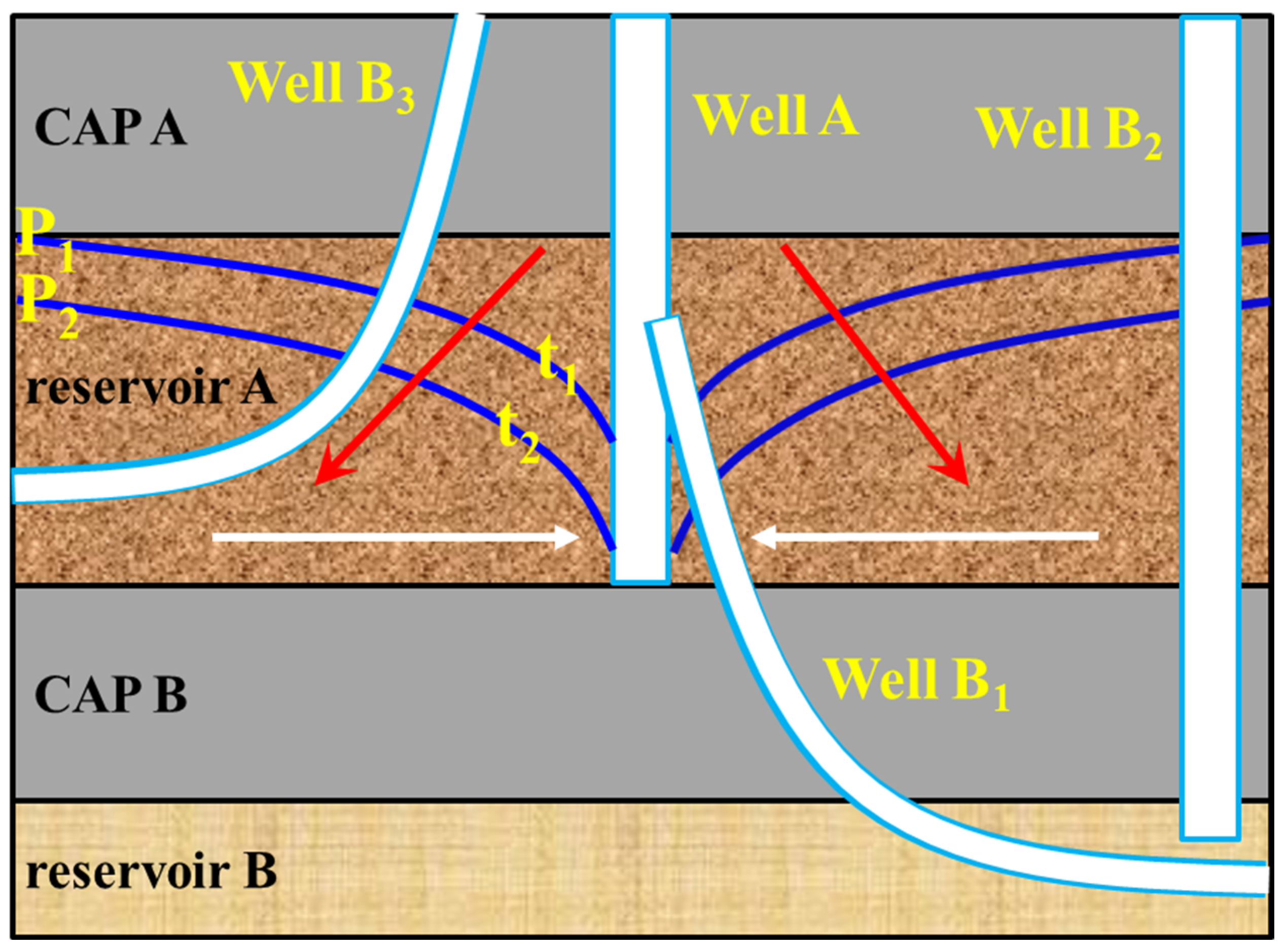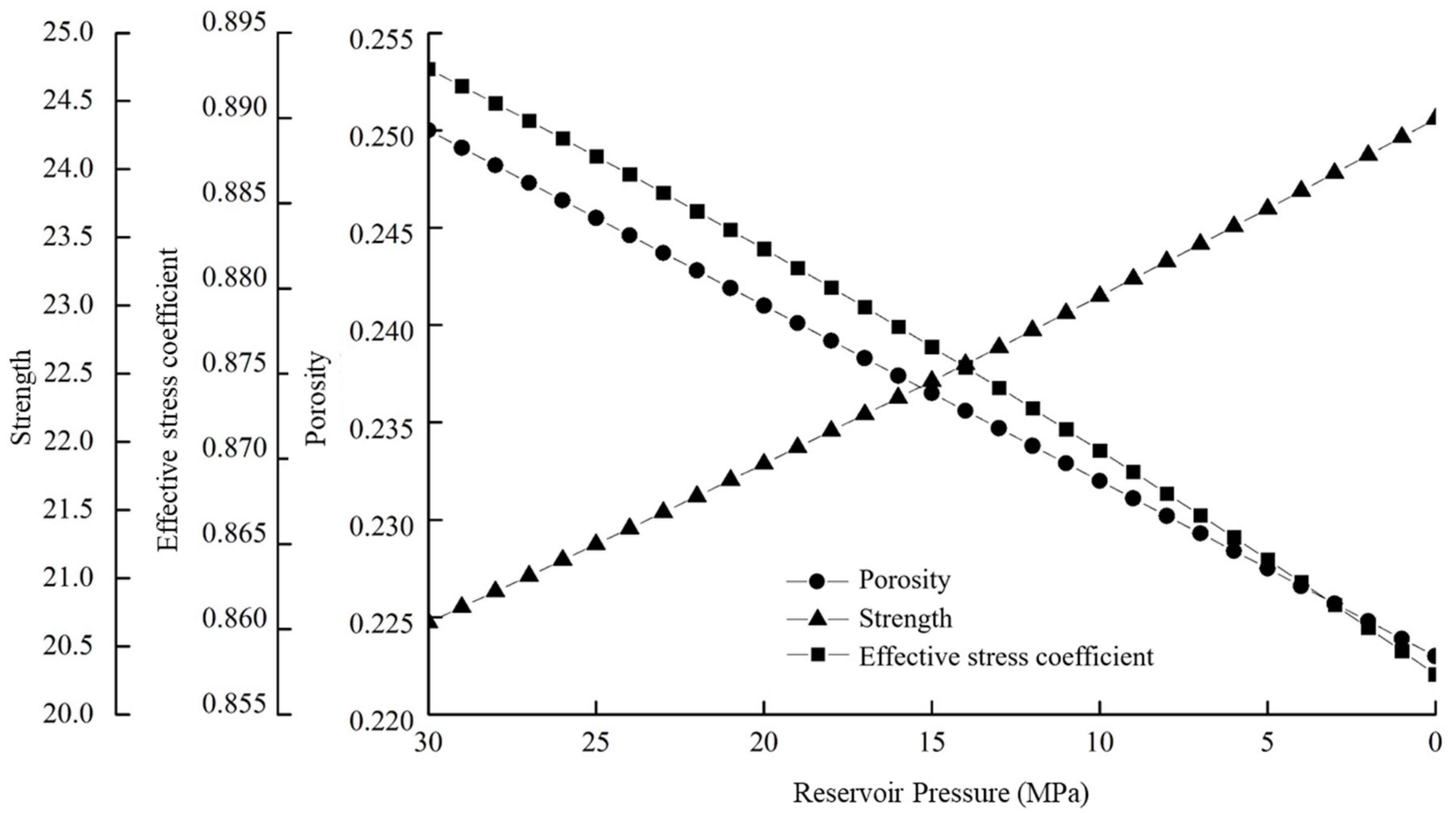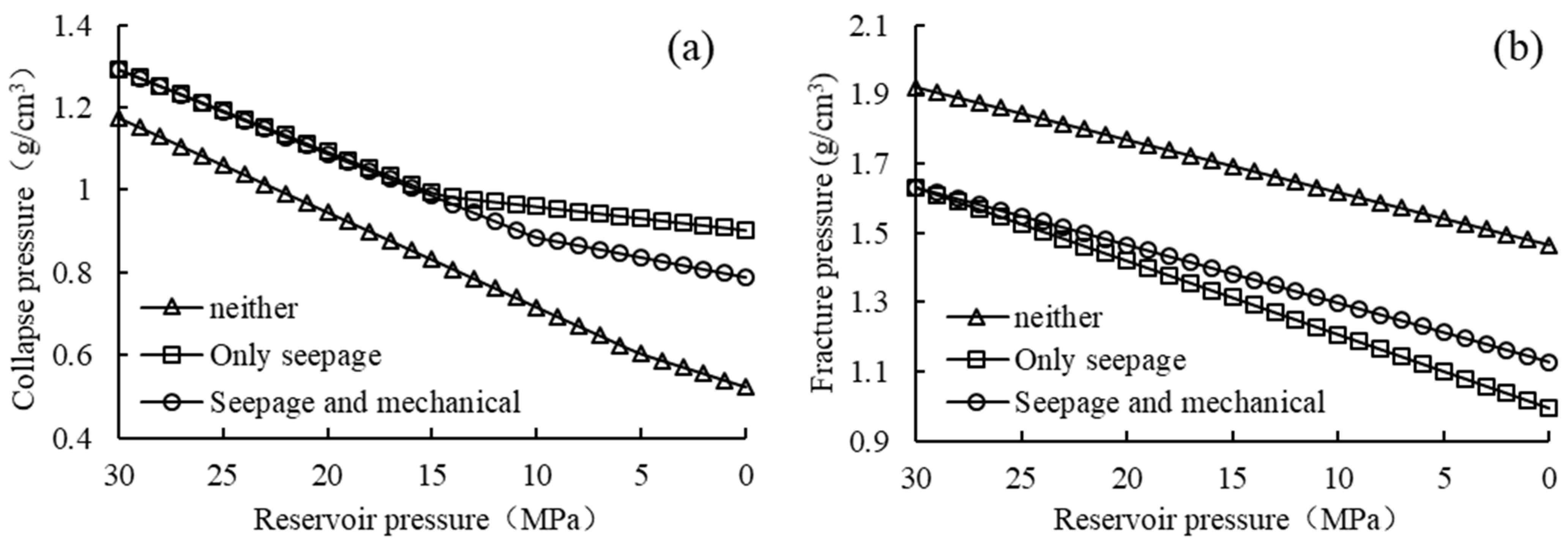Study on Wellbore Stability Evaluation Method of New Drilled Well in Old Reservoir
Abstract
:1. Introduction
2. Geomechanical Models
2.1. Pore Pressure
2.2. Porosity
2.3. Effective Stress Coefficient
2.4. Strength
2.5. In Situ Stress
2.5.1. In Situ Magnitude
2.5.2. Stress Direction
3. Borehole Stability Evaluation Model
3.1. Well Perimeter Stress
3.1.1. Concentrated Stress on In Situ Stress and Drilling Fluids
3.1.2. Additional Stress on Drilling Fluid Seepage
3.1.3. Total Stress Distribution around Borehole
3.2. Borehole Stability Analysis Model
4. Changes in Reservoir Mechanical Parameters and Well Wall Stability
4.1. Reservoir Pressure Changes
4.2. Induced Mechanical Parameter Changes
4.3. Change in Stress State around the Well
4.4. Well Wall Stability Changes
4.4.1. Stability of Newly Drilled Well Walls in Depleted Reservoirs with Borehole Location and Degree of Pressure Depletion in Producing Wells
4.4.2. Comparison of Results of Different Models for Calculating Changes in Well Wall Stability
4.4.3. Patterns of Change in Wall Stability of Newly Drilled Wells with Arbitrary Trajectories
5. Conclusions
- (1)
- Differences in the degree of pressure depletion in the reservoir plane around the well due to pressure depletion in production wells. The closer the location is to the producing well, the more severe the reservoir pressure depletion. The original direct use of dynamic reservoir pressure test data from producing wells to predict wall stability in newly drilled wells had large errors. As the reservoir pressure gradually decays, it results in a series of changes such as a reduction in reservoir porosity, a decrease in the effective stress factor, an increase in reservoir strength, a reduction in horizontal maximum ground stress, a reduction in horizontal minimum ground stress, and orientation deflection.
- (2)
- Changes in the stability of newly drilled well walls are influenced by a combination of factors, including reservoir pressure, changes in induced formation properties, and changes in seepage action. The new method combines the effects of these actions and allows for more accurate guidance on safe slurry density design.
- (3)
- Reservoir pressure depletion leads to an increased risk of leakage and changes in safe drilling orientation during the drilling process, which should be mainly prevented during the drilling process. The new drilling design can effectively ensure well wall stability through the reasonable design of the borehole trajectory, mud density, casing sealing, and strengthening the plugging with drilling.
Author Contributions
Funding
Institutional Review Board Statement
Informed Consent Statement
Data Availability Statement
Conflicts of Interest
References
- Zhou, X.; Luo, D.; Xu, Q.; Li, Y.; Yang, G.; Cao, Q.; Luo, F. Some strategical measures to tap the potential in offshore mature oilfields with extra-high water cut:a case of LFD13-1 field in Lufeng depression, Pearl River Mouth basin. China Offshore Oil Gas 2012, 24, 28–33. [Google Scholar]
- Zhou, L. Countermeasures for economical reserve increase in mature oilfields: A case study on Dagang oilfield. China Pet. Explor. 2018, 23, 20–28. [Google Scholar]
- Shaughnessy, J.; Fuqua, R.; Romo, L. Successfully drilling highly depleted sands. In Proceedings of the SPE/IADC Drilling Conference, Amsterdam, The Netherlands, 27 February–1 March 2001. [Google Scholar] [CrossRef]
- Jones, J.F.; Taylor, G.D.; Barree, R.D. Successfully managing drilling-fluid losses in multiple, highly depleted sands. SPE Drill. Completion 2003, 18, 182–187. [Google Scholar] [CrossRef]
- Xu, T.; Liu, Y.; Shen, W. Lost Circulation Resistance and Control Technology during Drilling; Petroleum Industry Press: Beijing, China, 1997; pp. 299–300. [Google Scholar]
- Mohamadian, N.; Ghorbani, H.; Wood, D.A.; Mehrad, M.; Davoodi, S.; Rashidi, S.; Soleimanian, A.; Shahvand, A.K. A geomechanical approach to casing collapse prediction in oil and gas wells aided by machine learning. J. Pet. Sci. Eng. 2021, 196, 107811. [Google Scholar] [CrossRef]
- Rashidi, S.; Mohamadian, N.; Ghorbani, H.; Wood, D.A.; Shahbazi, K.; Alvar, M.A. Shear Modulus Prediction of Embedded Pressurized Salt Layers and Pinpointing Zones at Risk of Casing Collapse in Oil and Gas Wells. J. Appl. Geophys. 2020, 183, 104205. [Google Scholar] [CrossRef]
- Ge, H.; Qu, J.; Huang, R. Fracture Pressure at Horizontal Intervals in Pressure Depletion Formotions. Pet. Drill. Tech. 1994, 22, 24–26. [Google Scholar]
- Addis, M.A. Reservior depletion and its effect on wellbore stability evaluation. Int. J. Rock Mech. Min. Sci. 1997, 34, 3–4. [Google Scholar] [CrossRef]
- Liang, H.; Wen, G.; Wang, G.; Zhang, Y.; Cheng, Y.; Zhao, J. The Effects of Pore Pressure Alterations on the In-situ Stress. Pet. Drill. Tech. 2004, 32, 18–20. [Google Scholar]
- Shi, M.; Jin, Y. Study on Wellbore Stability of Adunstment Well at the Middle and Late Stages of Oilfield Development. J. Oil Gas Technol. 2008, 30, 353–355. [Google Scholar]
- Tan, Q.; He, H.; Chen, Y.; Lu, W.; Duan, F. Wellbore Stability Analysis of Directional Wells in Pressure Depleted Reservoirs. J. Oil Gas Technol. 2010, 32, 316–318. [Google Scholar]
- Zhang, J.; Lei, G.; Zhang, Y. Oil and Gas Percolation Mechanics; China University of Petroleum Press: Dongying, China, 2006; pp. 37–40. [Google Scholar]
- Tian, H.; Deng, J.; Zhou, J.; Wang, Z. Reservoir compaction and surface subsidence induced by petroleum extraction. Rock Soil Mech. 2005, 26, 929–936. [Google Scholar]
- Geertsma, J. The effect of pressure decline on volumetric changes of porous rocks. Pet. Trans. AIME 1957, 210, 331–340. [Google Scholar] [CrossRef]
- Ge, H.; Han, D.; Chen, Y. Experimental investigation on poroelasticity of sandstones. Chin. J. Rock Mech. Eng. 2001, 20, 332–337. [Google Scholar]
- Chang, C.; Zoback, M.D.; Khaksar, A. Empirical relations between rock strength and physical properties in sedimentary rocks. J. Pet. Sci. Eng. 2006, 51, 223–237. [Google Scholar] [CrossRef]
- Wang, T.; Shi, W. Calculate Porosity by Density Logging. Coal Technol. 2010, 29, 151–165. [Google Scholar]
- Deng, J.; Cheng, Y.; Chen, M.; Yu, B. Prediction Technology of Wellbore Stability; Petroleum Industry Press: Beijing, China, 2008; pp. 6–7. [Google Scholar]
- Sonder, L.J. Effects of density contrasts on the orientation of stresses in the lithosphere: Relation to principal stress directions in the Traverse Ranges, California. TECTONICS 1990, 9, 761–771. [Google Scholar] [CrossRef]
- Segall, P.; Fitzgerald, S.D. A note on induced stress changesin hydrocarbon and geothermal reservoirs. Tectonophysics 1998, 289, 117–128. [Google Scholar] [CrossRef]
- Day-Lewis, A.D.F. Characterization and Modeling of In Situ Stress Heterogeneity; Stanford University: Stanford, CA, USA, 2007; p. 4552. [Google Scholar]
- Wang, S.; Li, H.; Li, D. Numerical Simulation of Hydraulic Fracture Propagation in Coal Seams with Discontinuous Natural Fracture Networks. Processes 2018, 6, 113. [Google Scholar] [CrossRef] [Green Version]
- Liu, L.; Li, L.; Elsworth, D.; Zhi, S.; Yu, Y. The Impact of Oriented Perforations on Fracture Propagation and Complexity in Hydraulic Fracturing. Processes 2018, 6, 213. [Google Scholar] [CrossRef] [Green Version]










| Lithology | Relationship Formula | Applicable Conditions |
|---|---|---|
| Sandstone | ||
| Shale | ||
| Limestone |
Publisher’s Note: MDPI stays neutral with regard to jurisdictional claims in published maps and institutional affiliations. |
© 2022 by the authors. Licensee MDPI, Basel, Switzerland. This article is an open access article distributed under the terms and conditions of the Creative Commons Attribution (CC BY) license (https://creativecommons.org/licenses/by/4.0/).
Share and Cite
Wang, S.; Liao, G.; Zhang, Z.; Wang, X. Study on Wellbore Stability Evaluation Method of New Drilled Well in Old Reservoir. Processes 2022, 10, 1334. https://doi.org/10.3390/pr10071334
Wang S, Liao G, Zhang Z, Wang X. Study on Wellbore Stability Evaluation Method of New Drilled Well in Old Reservoir. Processes. 2022; 10(7):1334. https://doi.org/10.3390/pr10071334
Chicago/Turabian StyleWang, Shiyue, Gaolong Liao, Zhenwei Zhang, and Xiaoyun Wang. 2022. "Study on Wellbore Stability Evaluation Method of New Drilled Well in Old Reservoir" Processes 10, no. 7: 1334. https://doi.org/10.3390/pr10071334
APA StyleWang, S., Liao, G., Zhang, Z., & Wang, X. (2022). Study on Wellbore Stability Evaluation Method of New Drilled Well in Old Reservoir. Processes, 10(7), 1334. https://doi.org/10.3390/pr10071334





